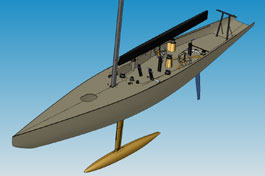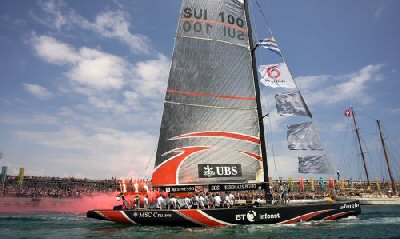Latest News
July 6, 2007
By Sara Ferris
 ETNZ designers created this solid model of the yacht’s keel. |
SolidWorks had a tough time deciding which yacht to root for in the 2007 America’s Cup yacht race, Emirates Team New Zealand (ETNZ) or Alinghi of Switzerland. Both contenders used SolidWorks software to optimize their designs for top performance within the America’s Cup guidelines. A range of features on both boats, including the hulls, winch mounts, and other deck hardware, was designed in SolidWorks to be durable, dependable, and as light as possible in the most demanding of racing conditions. Defending champion Alinghi won the closely contested race series, 5-2. The two teams also competed for the Cup in 2003, when Alinghi brought the Auld Mug trophy to Europe for the first time in 152 years. ETNZ has competed for the America’s Cup four times since 1987, winning twice.
Both teams built two entirely new yachts for the 2007 race, held in late June near Valencia, Spain. Boats must adhere to America’s Cup Class rules, which establish a relationship among various dimensions. Yachts must weigh a minimum of 24,000kg. By reducing the weight of the hull and rig, designers can add weight to the bulb, which provides greater stability and speed.
ETNZ used SolidWorks and COSMOSWorks design analysis software to develop and test new approaches to structural design such as the keel fin, which must support a weight of nearly 20,000 kilograms when the boat is heeled over under a strong wind. “Every stay, eye bolt, and winch must meet exacting standards so the boat performs to its maximum potential,” said Grant Dalton, managing director for ETNZ. “SolidWorks and COSMOSWorks let our engineers visualize different concepts and see new ways to make the boat faster.”
Carbon fiber materials are used for the hull, mast, deck, bulkheads, and many of the deck fittings. The goal is to achieve strength and reliability for the least possible weight. Designers go so far as to orient strands of carbon fiber exactly along the load lines for maximum strength. They also vary the number of laminated layers, adding more to high-stress areas.
Mechanical design engineers Neil Wilkinson and Jamie France work with other members of the 19-person design team to turn broader concepts into reality. They work with naval architects on hull shapes; appendage designers on rudders, keels, and bulbs; and the sailing crew on deck layout, the positioning of winches, travelers, and so on. They are responsible for generating specifications and detailed manufacturing drawings that go to machine shops, foundries, and other manufacturers. The ETNZ team also uses CFD (computational fluid dynamics) analysis to calculate the aerodynamics of masts and sails as well as water flow patterns over the keel assembly.
 Alinghi’s SUI100 boat ultimately won the 2007 America’s Cup. (Photo by Ivo Rovira/Alinghi) |
Shortly after its founding in 2000, Alinghi migrated from 2D drawings to SolidWorks 3D CAD to streamline development of components that require constant innovation to stay ahead of the competition. “SolidWorks had become so widespread in our industry it was important for us to speak the same design language as our suppliers,” said Grant Simmer, managing director and design team coordinator for Alinghi. “Our engineers use SolidWorks to design close to the edge so we can get the best performance from every single feature of the boat.”
Alinghi selected its newest boat, the SUI100, to defend the Cup. The SUI100 measures 80 feet (25m) long and is built from carbon fiber material. The design benefits from past work done by the 17-person design team. “We have put into this design all of the information we have been collecting from the two-boat testing program that has been underway since 2001 when we started Alinghi,” said Simmer. “We have been very pleased with SUI100’s performance since the launch on 17 March, and we have chosen it because we are very confident with its performance.”
Both teams believe that under the current set of America’s Cup class rules, there’s no room left for revolutionary design breakthroughs. Alinghi won the deciding race by one second over the ETNZ boat.
“Even though the boats are not that similar, in terms of their appendage packages and hull shapes, we thought it would be close,” said Alinghi’s Simmer. “This now is a contest of meters . . . . I’s so close now that every inch is significant.”
As the winning team, Alinghi plans to revise the class rules for the next America’s Cup race, extending the boat length to 90 feet and increasing crew size from 18 to 21.
“This is a design contest, a technology race,” said Alinghi skipper Brad Butterworth. “I think that’s the way the Cup has always been, and we are going to keep it that way.”
SolidWorks
www.solidworks.com
Alinghi
www.alinghi.com
ETNZ
http://www.emiratesteamnz.com/
Additional Resources
Simulating for an Edge
Sources: Press materials received from the company and additional information gleaned from the company’s website.
Subscribe to our FREE magazine, FREE email newsletters or both!
Latest News
About the Author
DE’s editors contribute news and new product announcements to Digital Engineering.
Press releases may be sent to them via [email protected].






